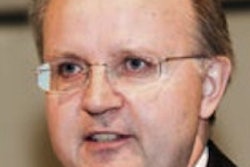An independent panel of more than 30 radiologists was unable to detect pathology found by radiologists testifying as expert witnesses for the plaintiff in a malpractice case, according to a study in the August issue of the American Journal of Roentgenology.
The study raises questions about the objectivity of expert witnesses in malpractice cases, according to lead author Richard Semelka, MD, from the University of North Carolina (UNC) in Chapel Hill. He suggests that using radiologists blinded to clinical outcomes rather than paid medical expert witnesses would be a better way to evaluate legal cases (AJR, August 2010, Vol. 195:2, pp. 429-431).
Lack of accountability
"Right now, there's no accountability or objectivity [in the testimony of expert medical witnesses]," Semelka told AuntMinnie.com. "That to me is a major root problem of the medicolegal debacle we're in. And to our knowledge, no studies have been performed to investigate the current practice of determining standard of care in these cases or to compare [that current practice] with scientific methods."
Semelka wanted to perform just such a study by comparing the findings of radiologists who testified as expert witnesses for plaintiffs against a panel of radiologists from the University of North Carolina. To blind the UNC reviewers, he mixed in one study from an actual malpractice case with a group of five unrelated studies that simulated a typical emergency department caseload. The reviewers were told that their participation was part of a study to evaluate the performance of individual diagnostic radiologists at the university's department of radiology, Semelka said.
Of the six studies, two had been performed for screening after major trauma, and one of these was the subject of the settled legal case. Three were chosen randomly from CT studies performed in the emergency department, and one was the control study.
In the CT exam that had been the subject of legal action, four radiologists who testified as expert witnesses for plaintiffs identified three things that had not been found by the primary reader: fractures in thoracic vertebrae three (T3) and 10 (T10), and a 1-mm symmetric widening of the facet joints at T10. This last finding was considered critical and was the basis for the legal case.
Next, 31 radiologists with no knowledge of clinical outcome of the litigation were selected to read the studies. Of these 31, none found the T3 fracture. Nineteen, or 63.3%, found the T10 fracture, and none found the key finding to the legal case, the 1-mm symmetric widening of the facet joints at T10.
Although the study's radiologist readers were not told that they were evaluating a legal case among the six CT cases, after the interpretations had been conducted, Semelka's team sent them an e-mailed questionnaire with a question about compensation for performing interpretations for legal cases. From this questionnaire, Semelka's group found that 10 of the 31 readers, or 32.2%, considered $100 to be adequate compensation for reading studies for a court-mandated interpretation.
A feasible model?
Why didn't 31 radiologists -- chosen from high-level academic settings, according to Semelka -- see the key finding that made the legal case? It's odd, according to Leonard Berlin, MD, professor of radiology at Rush University Medical College in Chicago and a frequent speaker on medical malpractice topics and other legal issues in radiology. Berlin was not involved in the Semelka study.
"That's a big discrepancy," Berlin said. "It doesn't seem logical that four experts for the plaintiff saw abnormalities but none of the 31 reviewers did."
It is unusual, Semelka acknowledged.
"My assumptions prior to this study were that medical experts render their opinions based on objective evaluation of evidence, and that there is real accountability on their part," he said. "I found neither of these to be the case. It's remarkable that you can have four highly regarded experts come up with an opinion on standard of care, and 31 blinded radiologists did not make the same observation. Something has to be done."
Using an external team of blinded readers for medical testimony would be relatively cost-effective and have significant effects, according to Semelka, although he conceded that the model might not be popular with lawyers.
"The truth is that we have people who are being paid by attorneys to represent what they want to be represented. But it's difficult to be objective if you're being paid," Semelka said. "This model would change the way lawyers practice, and there would likely be enormous pushback from them. They're used to having an expert under their control, to support their side of the case."
Changing the way law is practiced is a tough sell, and using the model suggested by the study is unrealistic, Berlin said. If there is a question as to whether an expert witness has delivered sound testimony, a complaint can be made to the American College of Radiology's (ACR) Committee on Ethics, which will investigate the complaint -- with the caveat that the expert witness must be an ACR member.
"This study suggests that the way malpractice suits should be conducted is with this panel of external, blinded readers, rather than an expert witness," he said. "But this is impractical and naive. In reality, the jury hears a single plaintiff's expert and a single defense expert."
The ultimate adjudicator of truth is blinded evaluation of experts, Semelka said.
"What we're suggesting [from the study] is not tort reform; that is, limiting damages in medicolegal cases," Semelka said. "We're suggesting that the way of establishing standard of care should be changed. There's just no better way to ensure justice than with a blinded approach."
By Kate Madden Yee
AuntMinnie.com staff writer
July 22, 2010
Related Reading
Abdominal CT malpractice suits aren't always doomsday, June 15, 2010
How to navigate ultrasound medicolegal issues, May 28, 2010
Leaders in Imaging: Dr. Leonard Berlin, May 25, 2010
Interpretation errors top clinical negligence claims in U.K., March 8, 2010
Communication failure: A surefire route to malpractice court, February 16, 2010
Copyright © 2010 AuntMinnie.com





















